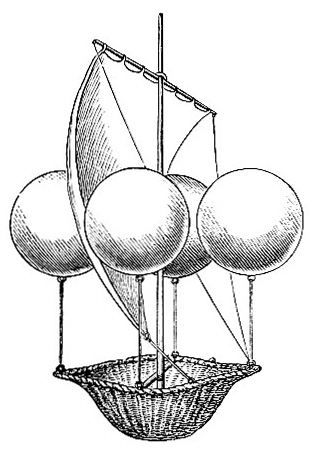Francis Lana. Joseph Galien. False Ideas Relating to Atmosphere.
The most noted scheme for navigating the air promulgated previously to the successful experiments of the Montgolfiers, is due to a Jesuit, Francis Lana and was proposed by him in a work entitled Prodromo dell' Arte Maestra, Brescia, 1670.
His idea, though useless and unpractical in so far that it could never be carried out, is yet deserving of notice, as the principles involved are sound; and this can be said of no earlier attempt. His project was to procure four copper balls of very large dimensions, yet so extremely thin that after the air was exhausted from them they would be lighter than the air displaced, and so would rise; and to those four balls he proposed to attach a boat, with sails, &c., and which would carry up a man. He submitted the whole matter to calculation, and proposed that the globes should be about 25 feet in diameter and 1th /225 of an inch in thickness; this would give from all four balls a total ascensional force of about 1200 lb, which would be quite enough to raise the boat, sails, passengers, &c. But the obvious objection to the whole scheme is, that it would be quite impossible to construct a globe of so large a size and of such small thickness which would even support its own weight without falling to pieces on the ground, much less bear the external atmospheric pressure when the internal air was removed. Lana himself noticed the latter objection, but he thought that the spherical form of the copper shell would, notwithstanding its extreme thinness, enable it, after the exhaustion was effected, to sustain the enormous pressure, which, acting equally on every point of the surface would tend to consolidate rather than to break the metal. Of course this assumed the ball to be absolutely spherical, a state of affairs as impossible as indifferent equilibrium actually is. He proposed to exhaust the air from the globes by attaching each to a tube 36 feet long, fitted with a stopcock, and so produce a Torricellian vacuum. He was thus apparently ignorant of the invention of the airpump by Otto Guericks about 1650; and though his project is noteworthy as the hydrostatics of it is correct, still Lana displays his ignorance of philosophical facts known in his day, quite as much as his originality; and his proposition has, since Montgolfer's discover, received a greater share of notice than it deserves.
So late as 1755, and not long before the invention of balloon, a very fanciful scheme was proposed by Joseph Galien, a Dominican friar, and professor of philosophy and theology in the papal university of Avignon. This visionary proposed to collect the diffuse air of the upper regions, and to enclose it in a huge vessel extending more than a mile every way, and intended to carry fifty-four times as much weight as did Noah's ark. It is unnecessary to notice at greater length thus absurd chimera, which is merely mentioned here at all because it is sometimes referred to, though only on account of the magnitude of the fantastic scheme.
It is proper here to remark, that nearly all the early projectors imagined that the atmosphere was of no great height, and that it covered the earth like a shallow ocean havinga well --defined boundary; and the aerial vessels which they proposed were intended to float on the surface of this ocean, exactly as ships do on the sea, with their upper portions in the ether or diffuse air, or whatever the fluid might be, that lay above. And these ideas were, of course, not dispelled till after the invention of the barometer and the discovery of the law of the decrease of atmospheric pressure with elevation.
Read the rest of this article:
Aeronautics - Table of Contents
